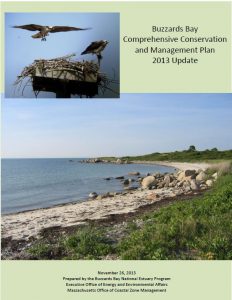2013 CCMP, Action Plan 15:
Managing Coastal Watersheets, Tidelands, and the Waterfront
About the new Buzzards Bay CCMP Action Plans
The Buzzards Bay Comprehensive Conservation and Management Plan (CCMP) was updated in November 2013 to reflect the great progress achieved since the original CCMP was finalized. You can download the entire document (buzzards-bay-ccmp-2013-update.pdf) or just this action plan Managing Coastal Watersheets, Tidelands, and the Waterfront.
Managing Coastal Watersheets and the Waterfront
Problem
In coastal waters, new docks, increased boating, new waterfront development, and dredging and coastal armoring to support those activities, continue to degrade water quality, destroy habitat, and affect marine plant and animal populations. Other activities, like aquaculture, are also expanding. All levels of government have some jurisdiction over activities on the water’s surface (commonly called the watersheet), on the seabed (tide-lands under Massachusetts law), and on the waterfront. The Massachusetts Ocean Management Plan, adopted in 2009, better regulates activities in areas greater than 1/3 mile offshore. Municipalities, with home rule powers, remain a key manager of nearshore areas not covered by the Ocean Plan (and which includes most of the harbors and embayments; see EEA, 2009). These nearshore areas are now imperfectly managed principally through local and state waterways regulations and wetlands permitting. Most municipalities have failed to undertake comprehensive planning studies of their coastal waters to protect natural resources or address cumulative impacts.
To address these needs, towns must develop local embayment management plans based on spatial planning techniques to characterize conditions and recommend action. These plans must then be implemented through laws, regulations, and policies, together with non-regulatory approaches and education.
This action plan seeks principally to address conflicting uses and management priorities for the waterfront and near coastal watersheets not addressed by the Massachusetts Ocean Management Plan, including nearshore renewable energy facilities. Issues associated with discharges from boat operation and maintenance, and adverse impacts from boat mooring systems are addressed in Action Plan 6 Managing Impacts from Boating, Marinas, and Moorings.
Goals
Goal 15.1. To manage the uses and activities in the waters and on the tidelands of Buzzards Bay in an integrated manner using sound assessments of natural resources, habitat, and water quality, to ensure sustainable recreational and commercial activities while protecting and improving ecosystem health and values.
Goal 15.2. Ensure that the effects of dredging activities are minimized on water quality, physical processes, marine productivity, and public health, and that the beneficial use of dredged sediments is maximized.
Objectives
Objective 15.1. Develop and improve upon geographic databases identifying habitat, natural resources, seabed characteristics, and contamination or impairment hotspots of lands under the ocean to establish a strong technical basis for embayment watersheet planning and management.
Objective 15.2. Promote the development and implementation of municipal embayment management plans to manage the watersheet, protect water quality, vital natural resources, and tideland habitat, and increase shoreline resilience to storms and rising sea level, while allowing sustainable uses.
Objective 15.3. Ensure that dredging methods and timing be conducted to minimize adverse impacts, and where appropriate, transfer sensitive resources out of areas to be dredged.
Objective 15.4. To maximize the beneficial uses of dredged material by creating opportunities by pre-designating or pre-permitting receiving areas (e.g. beach nourishment zones) to expedite permitting, and through increased funding.
Approaches
Towns must evaluate spatial data and characterize coastal uses to develop comprehensive embayment man-agement plans that define watersheet and waterfront protection strategies. These plans will be fulfilled through town zoning, waterways regulations, wetland regulations, or town bylaws and city ordinances and non-regulatory approaches. Such plans may create conservation areas or activity exclusion zones, or create incentives for certain activities. While the cost to develop such plans is a hurdle, the key obstacle to implementation is developing a political consensus to pass the necessary zoning and nonzoning laws or regulations. With respect to dredging, the increased beneficial use of dredged materials could be facilitated by preselecting and pre-permitting receptor sites and through additional funding.
Costs and Financing
Based on recent town efforts, the cost of developing a resource protection based embayment plan is typically $50-$100,000 per embayment. Some state and federal grant programs can be used to fund these efforts, but most often municipal legislative bodies appropriate the necessary funds.
Measuring Success
This action plan is evaluated by programmatic actions by towns developing and adopting needed waterfront and watersheet management plans and policies.
